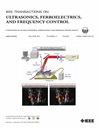Ultrasparse Ultrasonic Synthetic Aperture Focus Imaging by Passive Sensing
IF 3
2区 工程技术
Q1 ACOUSTICS
IEEE transactions on ultrasonics, ferroelectrics, and frequency control
Pub Date : 2024-03-26
DOI:10.1109/TUFFC.2024.3382231
引用次数: 0
Abstract
Ultrasonic synthetic aperture focus techniques (SAFTs) using less than the total number of available array elements to transmit (“sparse” transmissions) have been recently used in both medical imaging and industrial nondestructive testing (NDT) imaging to increase test speed and simplify multiplexer hardware. The challenge of sparse arrays is to obtain a reasonable image quality given the reduced transmitter–receiver combinations available to the beamforming process. This article proposes a “ultrasparse” SAFT method that employs a minimum number of transmitter elements (from one to four elements only) to obtain an entire full-matrix capture (FMC) set of waveforms. Specifically, a “virtual” FMC is obtained from normalized cross-power spectra between each array element pair in an implementation of “passive” ultrasonic sensing. In order to maintain high image quality without sacrificing imaging speed (e.g., applying a minimal initial time delay and keeping a short time recording window), several key steps have to be taken in this “passive” imaging mode, specifically: 1) the use of carefully designed segment-averaged normalized cross-power spectrum (NCPS) for robust passive reconstruction of the ultrasonic impulse response function (IRF) between two receivers; 2) the use of both the causal and acausal portions of the passively reconstructed IRFs; and 3) the compounding of multiple wave modes in the beamforming process. These steps also ensure the elimination of the near-field blind zone hence potentially enabling near-field imaging. The article first reviews the theory of passive IRF reconstruction between two receivers, comparing time-averaged cross correlation versus segment-averaged NCPS, and then demonstrates the application to ultrasparse SAFT FMC imaging of drilled holes in an aluminum block using a linear transducer array where only one to four elements are used in transmission.Ultrasparse 通过被动传感进行超声波合成孔径聚焦成像。
超声波合成孔径聚焦技术(SAFT)使用少于可用阵元总数的发射("稀疏 "发射),最近已被用于医疗成像和工业无损检测成像,以提高测试速度并简化多路复用器硬件。稀疏阵列所面临的挑战是,如何在波束成形过程中利用较少的发射器-接收器组合获得合理的图像质量。本文提出了一种 "超解析 "SAFT 方法,它只需使用最少数量的发射器元件(从一个到四个元件不等),就能获得整个全矩阵捕获(FMC)波形集。具体地说,在 "被动 "超声波传感的实施过程中,从每个阵列元件对之间的归一化交叉功率频谱中获取 "虚拟 "全矩阵捕获(FMC)。为了在不牺牲成像速度的情况下保持高图像质量(例如(a) 使用精心设计的分段平均归一化交叉功率谱,对两个接收器之间的超声波脉冲响应函数(IRF)进行稳健的被动重建;(b) 同时使用被动重建的 IRF 的因果和非因果部分;(c) 在波束成形过程中复合多种波模式。这些步骤还能确保消除近场盲区,从而实现近场成像。论文首先回顾了两个接收器之间的被动 IRF 重建理论,比较了时间平均交叉相关与分段平均归一化交叉功率谱,然后演示了如何利用线性换能器阵列对铝块上的钻孔进行超解析 SAFT FMC 成像,其中只使用了一到四个传输元件。
本文章由计算机程序翻译,如有差异,请以英文原文为准。
求助全文
约1分钟内获得全文
求助全文
来源期刊
CiteScore
7.70
自引率
16.70%
发文量
583
审稿时长
4.5 months
期刊介绍:
IEEE Transactions on Ultrasonics, Ferroelectrics and Frequency Control includes the theory, technology, materials, and applications relating to: (1) the generation, transmission, and detection of ultrasonic waves and related phenomena; (2) medical ultrasound, including hyperthermia, bioeffects, tissue characterization and imaging; (3) ferroelectric, piezoelectric, and piezomagnetic materials, including crystals, polycrystalline solids, films, polymers, and composites; (4) frequency control, timing and time distribution, including crystal oscillators and other means of classical frequency control, and atomic, molecular and laser frequency control standards. Areas of interest range from fundamental studies to the design and/or applications of devices and systems.

 求助内容:
求助内容: 应助结果提醒方式:
应助结果提醒方式:


